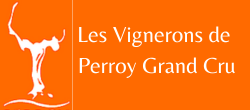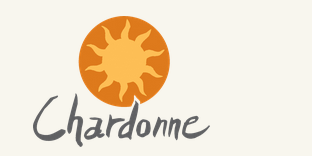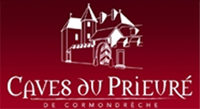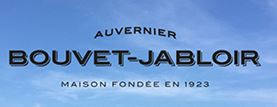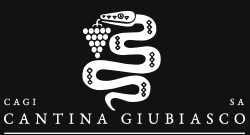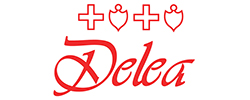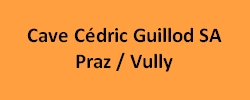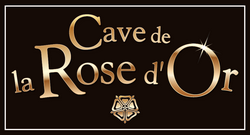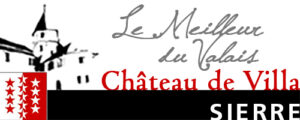The autumn taste of a Swiss Village, Salquenen
Pinot Noir is the grape providing some of the finest wines in the world, the most famous ones being those from Burgundy region in France.
The style of each appellation and, after, of each winemaker is so different, but in general, there are light – medium bodied wines with a present acidity and moderated tannins. One would believe that Pinot Noir can be drunk earlier, but the best example need time to fully develop. The aromatic evolution is very interesting, and the palette of aromas and flavors develops under your eyes, from fresh red fruits with a touch of cinnamon, cloves, depending on the ageing choice, to cooked fruits and marmalade on the hot vintages, evaluating to fried fruits, cooking spices, aromatic herbs, game, forest floor, cigar box and truffle.
The Swiss Canton of Valais is very famous for the local varieties (like Petite Arvine) but a careful regard will show you that the international grapes can get here a fine expression too. Pinot Noir was largely planted after last century issues (the most serious being phylloxera) because of its ‘nobility’but also because it was easier to grow than some local varieties. Salquenen village from Haut-Valais (the german speaking part of the canton) has so important plantings that it made its key product. This was possible due to its special geographical conditions: a soil dominated by limestone rich in magnesium and a mild climate.
More than that, 30 years ago they created the Grand Cru association, being the first Grand Cru in Switzerland. The wines, commercialized under this label, pass a serious control and different tastings. One of the most important conditions is that the yields are limited at 800 g/m² and the most surprising one is that the wines are not allowed to be aged in oak barrels! Also, there is a minimum of 15 months of bottle ageing. Today, with the issue of global warming, new questions are rising about keeping or changing the rules.
In the beginning of September, the winemakers of Salquenen prepared a special tasting celebrating the 30 years of Grand Cru, where bottles from each vintage were tasted by wine professionals and journalists. They had also the pleasure to enjoy and appreciate other wines made in the village, whites and reds, paired with a special menu in the gastronomical restaurant of Zermatterhof, a 5* hotel from the unique Zermatt Village.
Food and wine pairing:
-
Octopus with rucola, fennel, chorizo and Belper Knolle (a Swiss Cheese made in Bern canton from caw milk and garnished with garlic powder, salt and pepper)
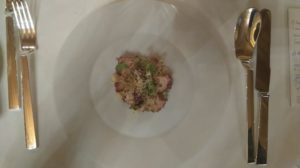
-
Sauvignon Blanc 2017, Fernand Cina – aromas of very ripe fruits and a touch of exotic (mango, pineapple) but with the typical characteristics of sauvignon blanc: ripe gooseberries and elderflower. Very elegant, with a long finish.
-
Petite Arvine Altimus 2016, Luxvina, Domaine Chevaliers – the nose is impressive, the resinous aromas making you wonder if it was aged in oak barrels! The varietal characteristics: floral, ripe fruits and citrus are showing up. Very dry on the palate, with present alcohol.
-
Viognier 2017, Cave Chez Violaine Wenger & Marti – very perfumed, with floral aromas and stone fruits aromas (peach and apricot). Not too heavy on the palate, with a silky texture.
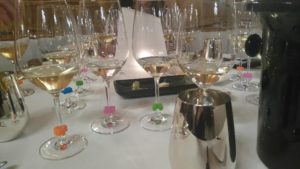
-
Gambero Rosso – fregola sarda (small Italian pasta originally from Sardinia), Taggiasca olive, Mund Safran (Mund is the only Swiss village where this noble spice is still produced – around 3 kg/year. It enjoys it’s ‘protected appellation’)
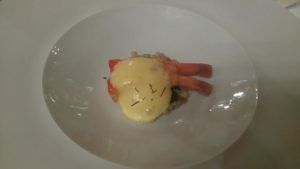
-
Johannisberg ‘Goldtropfen’ Gros Rhin 2017, Weinschmiede – delicate aromas on the nose: fresh pineapple, tangerine and lemon juice. On the palate it has a light body with almonds, dried linden flowers and hays but also some fresh herbs flavours too.
-
Heida Visperterminen 2017, Edmond Constantin – a surprising nose given, probably, by the barred ageing. With a medium body and acidity, on the palate the hazelnuts, fresh nuts and vanilla flavors are dominating. The finish is long.
-
Ambassadeur 2016, Domaines Diego Mathier (a blend of Marsanne, called Ermitage in Valais, Savagnin – called Heida and Petite Arvine) – concentrate scents of flowers and dried fruits. You feel the oak barrel influence but it’s very well integrated. Intense flavours on the palate, a high acidity and a long, lingering finish.
-
Tarte Tatin – foie gras, Zermatt honey, nectarines
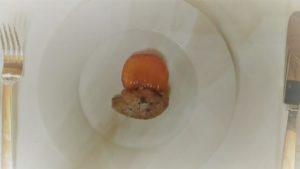
-
Marsanne Blanche Dom. Trong Bio 2015, Cave du Rhodan – with an intense floral garden nose, the dried fruits and vanilla aromas remembering the barrel influence. On the palate, you would remark the creamy texture balanced by a medium acidity.
-
Chardonnay ‘Noemie’ 2017, Domaine de l’Enfer – complex and exuberant nose but elegant in the same time. On the palate, medium plus body and the exotic flavors are combined to the stone fruits and citrus. The finish is long.
-
‘Nuit Blanche’ 2016, Gregor Kuonen, Caveau du Salquenen – this is a Pinot Noir vinified in white a surprise! the best is to taste it!
-
‘Pluie d’Or’ 2017, Josef Glenz & Töchter – shows up its tenderness and drinkability.
-
Quail – fried egg, chanterelle mushrooms
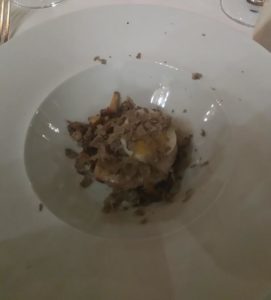
-
Pinot Noir Grand Cru 2016, Domaine de l’Enfer – it’s elegant and delicate with a floral nose and fresh cherries aromas. On the palate, the tannins are light and the acidity medium. Very digest.
-
Humagne Rouge 2016, Cave Chez Violaine Wenger – a wonderful local red variety which will amaze you through its aromas of dried flowers, ripe cherries, blackberries and a touch of animal scent. It’s not heavy but quite delicate. The tannins are suave.
-
Cornalin ‘Goigglar’ 2016, Edmund Constantin – the nose is more intense, riper, more jammy, fruit forward (black fruits, black cherries, rosehip berries). It’s very flavorful on the palate, with medium tannins and everything is balanced by a medium acidity with make it more digest.
-
Fortissimo du Rhodan 2015, Cave du Rhodan – a blend of Cornalin and Diolinoir: shows up with more barrel influence and drier tannins.
-
Irish Beef Club – funghi porcini, pesto, polenta bianco, celery and tomatoes
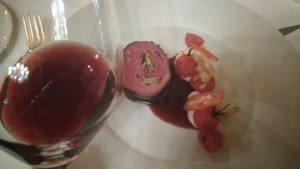
-
Ambassadeur 2013, Domaines Diego Mathier – an elegant Pinot Noir with a medium body.
-
Cornalin 2015, Cave St. Phillippe – dominating aromas of fresh raspberries and strawberries. Surprising light tannins on the palate and a medium acidity.
-
Tre Vini ‘Les Deux Apôtres’ 2015, Weinschmiede – a blend of Pinot Noir, Syrah and Cornalin: the delicate nose, very elegant, showing its potential in a couple of years.
-
Syrah 2016, Joseph Glenz – more intense and more complex but with a nice acidity that comes to balance the wine. Very elegant.
-
Millefeuille – Tahiti Vanilla, White Chocolate Mousse, strawberries and fresh berries
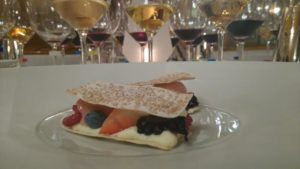
-
Grains Nobles ‘Lux Vina’ 2015, Dom. Chevaliers – a blend of Pinot Gris and White Marsanne: a luscious wine with high content of sugar and delightful long taste of quince, roasted pineapple but also strawberry and savory white mushrooms!
-
Blanc de glace 2016, Gregor Kuonen – my favorite because of its unique aromatic profile: wisteria blossom, raspberries, strawberries, rich in texture but lovely balanced by the acidity. A long aftertaste too!
-
Les fers de lance 2016, Cave St. Philippe – a Pinot Gris with an intense but elegant nose of flowers and stone fruits (very ripe apricots) and a touch of minerality. On the palate it’s intense but very digest (the importance of keeping the acidity on the wine).
I think that more important than finding the best pairing was giving the guests the opportunity to taste and discover a large selection of the wines produced in the village and the different winemakers.
30 YEARS OF SALQUENEN GRAND CRU
Not only September marked the anniversary of this Grand Cru but the beginning of autumn was the best moment for seeing the evolution of Pinot Noir. It marks a start for a new season, with new flavors, when you leave the fresh in order to appreciate the development and time’s fingerprint. These wines pair very well with the autumn food. Just think of all the garnishes made from butternut, chestnut, nuts, mushrooms, dried beans, beetroots, baked apples etc! Pinot Noir’s fresh fruit, usually very ripe, even jammy in Valais, changes to dried fruits, the mono-dimensional ‘fruity’ wines gain an incredible aromatic complexity where the tertiary dominate the bouquet: dates, dried figs, aromatic herbs, forest floor, dried leaves and flowers, noble spices, coffee and leather. Depending on the vintage but, in most of the cases, the acidity is dropping, the alcohol is well integrated and diminishes, the tannins melt, resulting in a souple body and silky texture. The delicate and discrete nose of wines from cold vintages should be appreciate and it comes often with an extra point of freshness on the palate. Just remember, old wines can be very persistent on the palate, sometimes being difficult to pass fast to another wine. We started with the older vintages, but I wish I could have the chance tasting them starting from the youngest one! 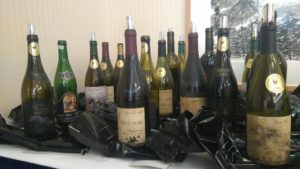
In order not to be boring, I want to present you the vintages in just one phrase:
1988 – three wines, all dominated by the tertiary flavors (dates, prunes, spices, bay leaf, coffee), the first being the spiciest, the third – the ripest and the second with an alcohol more present but a shorter finish.
1989 – just one wine: nose more discreet, more elegant but intense on the palate, very earthy, with its cumin touch.
1991 – two wines, the first one being more delightful with its dry fruit, a little oxidized, very earthy too but with a surprising acidity and long finish.
1992 – only one wine with a medium intensity nose but intense, perfumed flavors of dried flowers; different because it’s less earthy and spicy but with a long finish and a more present alcohol.
1993 – the ripeness on the nose foretastes the mildness of the palate.
1994 – its elegance is given by its lightness and a touch of freshness, alluring with its delicate fruit, spicy and autumn leaves aromas.
1995 – the year of changings! The hue is less evaluated, more profound, the quality of fruit is changing towards dried and macerated cherries, a complex bouquet and a surprising palate with more body and velvety tannins.
1996 – more body given by the sweetness but a present acidity and a nice long finish.
1997 – three wines (the less complex was the third one) with intense brick hue which announces an intense nose, towards a jammy fruit and having more structure given by tannins and alcohol.
1998 – the first wine is too oxidized but the second comes with more complexity on the nose, some tannins and a light body
2000 – three wines with intense nose, more on the cooked cherries, cinnamon, and fresh grinded coffee; on the palate the alcohol and tannins are giving a nice structure; the preference would be to the last one, less expressive but more complex!
2001 – another 3 wines sharing only the sweet fruit taste, after quite different: from fresh and elegant to animal and savage!
2002 – elegant but quite complex in aromas, the sweet fruit attack being followed by a surprising acidity.
2003 – one wine with a light nose but very spicy on the palate, going from nutmeg to pepper, sustained by a noticeable freshness.
2004 – two wines light and easy in general.
2005 – the first more herbal, fresh with present tannins and the second more ‘mono-dimension’, on the fruit-forward side (prunes).
2006 – quite light with a fresher cherry fruit flavor.
2007 – very interesting with its ripe, sweet fruit finished with coffee flavours; balanced by a nice acidity.
2008 – strange vintage with 2 wines going from a closed nose to an animal and a medicinal one, from a fresh palate to a dry finish
2009 – 3 different wines: the first is having a nice structure, body and intense and long flavours of ripe dark cherry and aromatic herbs, the second just fruity (red fruits sauce) and the third very elegant with a long finish on fried fruits and herbs.
2010 – 3 pleasurable examples with present tannins, alcohol, a gentle preference towards the first one.
2011 – another 3 wines but the first two rise up with lightness and freshness.
2012, 2013 – the same suppleness but aromatically different.
2014 – coming with a medium body and more ripeness but the second wine is more enjoyable for the acidity that makes it more drinkable and elegant with notes of fresh red fruits, violet and thyme.
2015 – 4 wines varying from lack of freshness to an enjoyable acidity, from light to medium bodied.
For the recent vintages, don’t hesitate to contact me or directly the winemakers from the village!
A big Thank You for all those who made this tasting possible and, especially, to the winemakers for all their effort, for the continuous work, passion and for their desire to share it!

